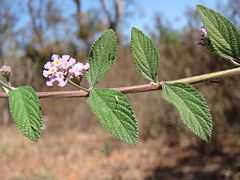Lippia alba
| Lippia alba | |
|---|---|
 | |
| Scientific classification | |
| Kingdom: | Plantae |
| (unranked): | Angiosperms |
| (unranked): | Eudicots |
| (unranked): | Asterids |
| Order: | Lamiales |
| Family: | Verbenaceae |
| Genus: | Lippia |
| Species: | L. alba |
| Binomial name | |
| Lippia alba (Mill.) N.E.Br. ex Britton & P.Wilson[1] | |
| Synonyms[2] | |
|
List
| |
Lippia alba is a species of flowering plant in the verbena family, Verbenaceae, that is native to southern Texas in the United States,[3] Mexico, the Caribbean, Central America, and South America. The species is also present in Australia and India, were it is probably a human introduction.[4] Common names include Bushy Matgrass,[1] Bushy Lippia, Hierba Negra,[3] and Pitiona.[5] It is a multi-branched shrub, reaching a height of 1.5 m (4.9 ft). Leaves measure 1 to 3 cm (0.39 to 1.18 in) in length and 0.9 to 2 cm (0.35 to 0.79 in) in width and are opposite or in threes. Flowers with white, pink, or light blue-purple corollas form on spikes 2 cm (0.79 in) long.[6]
Uses
Bushy Lippia is widely cultivated as an ornamental for its aromatic foliage and beautiful flowers.[3] The essential oil composition is unique to each plant, but may include piperitone, geranial, neral, caryophyllene, camphor, eucalyptol, limonene, carvone, germacrene, α-guaiene, β-ocimene, linalool, or myrcene.[6] The leaves are used for flavoring foods,[7] such as mole sauces from Oaxaca, Mexico.[8] The plant is used medicinally for its somatic, sedative, antidepressant, and analgesic properties.[9]
References
- ↑ 1.0 1.1 "Taxon: Lippia alba (Mill.) N. E. Br. ex Britton & P. Wilson". Germplasm Resources Information Network. United States Department of Agriculture. 2006-02-02. Retrieved 2010-01-21.
- ↑ "The Plant List: A Working List of All Plant Species". Retrieved February 8, 2014.
- ↑ 3.0 3.1 3.2 "Bushy Lippia, White-flowered Lippia, Hierba Negra, Hierba del Negro, Hierba Buena, Alfombirlla, Cidrilla, Oregano de Burro, Salva do Brasil, Salva Colorado, Te de Castilla, Toronjil de Espana Mirto, Juan slama, Salvia, Sonora, Mastranto, Te del Pais, Te de Maceta, Te del Pan Lippia alba (L. geminata)". Benny Simpson's Texas Native Shrubs. Texas A&M University. Retrieved 2010-01-21.
- ↑ Munir, A.A. (1993b). A taxonomic revision of the genus Lippia [Houst. ex] L. (Verbenaceae) in Australia. J Adelaide Bot Gard. 15(2): 129-145.
- ↑ Allen, Gary (2007). The Herbalist in the Kitchen. University of Illinois Press. p. 423. ISBN 978-0-252-03162-5.
- ↑ 6.0 6.1 Tucker, Arthur O.; Thomas DeBaggio (2009). The Encyclopedia of Herbs: A Comprehensive Reference to Herbs of Flavor and Fragrance (2 ed.). Timber Press. pp. 298–299. ISBN 978-0-88192-994-2.
- ↑ Duke, James A. (2008). Duke's Handbook of Medicinal Plants of Latin America. CRC Press. pp. 412–414. ISBN 978-1-4200-4316-7.
- ↑ "La Pitiona". Pitiona. Retrieved 2012-08-24.
- ↑ "Lippia alba Prontoalivio, Erva cidreira, juanilama, Melissa". United Nations Conference on Trade and Development. January 2005.
External links
![]() Media related to Lippia alba at Wikimedia Commons
Media related to Lippia alba at Wikimedia Commons
![]() Data related to Lippia alba at Wikispecies
Data related to Lippia alba at Wikispecies